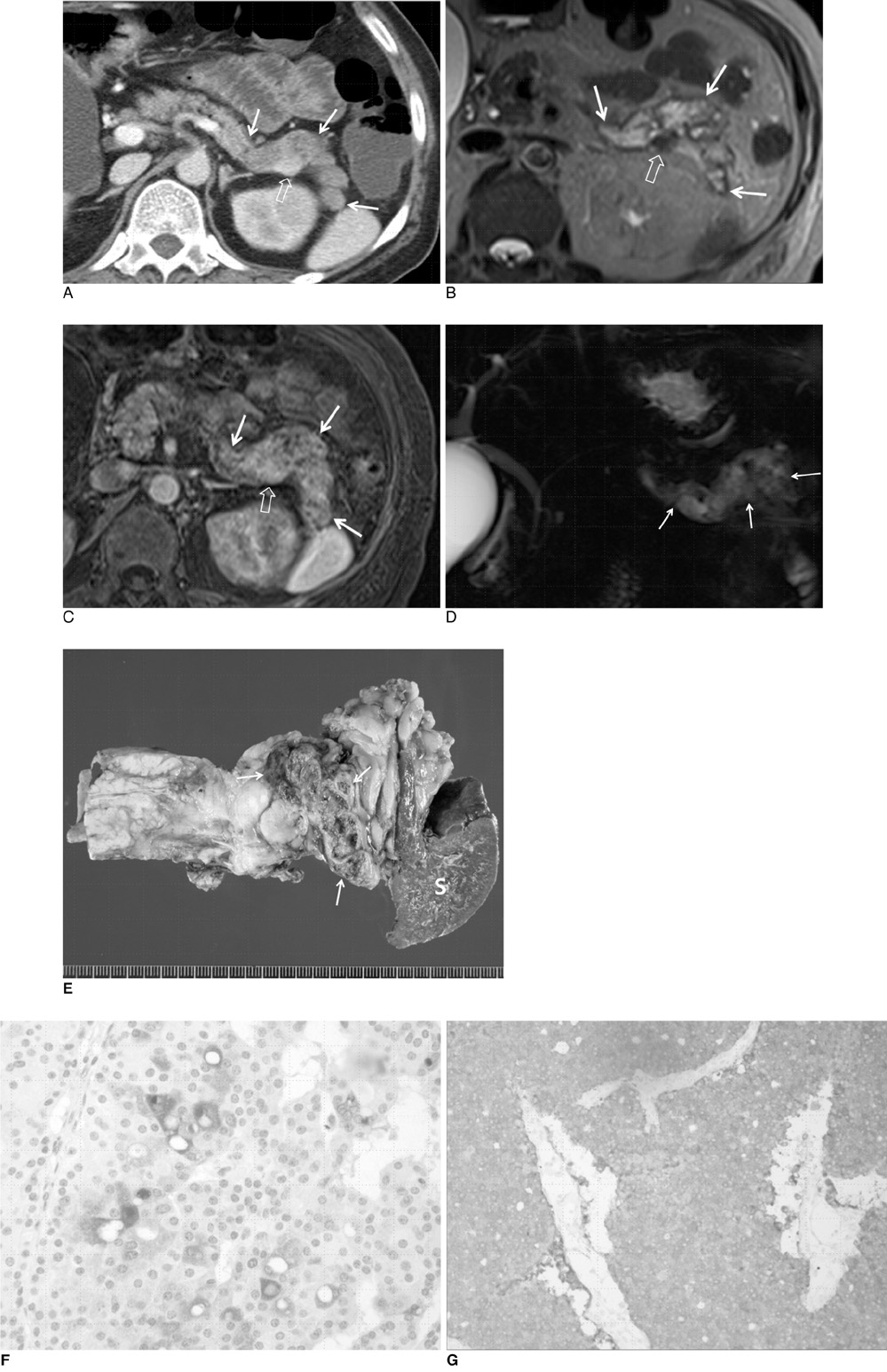Korean J Radiol.
2010 Jun;11(3):378-381. 10.3348/kjr.2010.11.3.378.
Imaging Findings in a Case of Mixed Acinar-Endocrine Carcinoma of the Pancreas
- Affiliations
-
- 1Department of Radiology and Research Institute of Radiology, University of Ulsan College of Medicine, Asan Medical Center, Seoul 138-736, Korea. jhbyun@amc.seoul.kr
- KMID: 946281
- DOI: http://doi.org/10.3348/kjr.2010.11.3.378
Abstract
- Mixed acinar-endocrine carcinoma (MAEC) of the pancreas is extremely uncommon. We report here a rare case of MAEC of the pancreas presenting as watery diarrhea. This is the first report in the English-language literature that describes the imaging findings of MAEC of the pancreas, including computed tomography (CT), magnetic resonance (MR) imaging, and MR cholangiopancreatography features.
MeSH Terms
-
Carcinoma, Acinar Cell/*pathology/*radiography/surgery
Cholangiopancreatography, Magnetic Resonance/methods
Diagnosis, Differential
Diarrhea
Endocrine Gland Neoplasms/*pathology/*radiography/surgery
Female
Humans
Magnetic Resonance Imaging/methods
Middle Aged
Pancreas/pathology/radiography/surgery
Pancreatectomy
Pancreatic Neoplasms/*pathology/*radiography/surgery
Splenectomy
Tomography, X-Ray Computed/methods
Figure
Reference
-
1. Kamisawa T, Tu Y, Egawa N, Ishiwata J, Tsuruta K, Okamoto A, et al. Ductal and acinar differentiation in pancreatic endocrine tumors. Dig Dis Sci. 2002. 47:2254–2261.2. Klöppel G. Mixed exocrine-endocrine tumors of the pancreas. Semin Diagn Pathol. 2000. 17:104–108.3. Schron DS, Mendelsohn G. Pancreatic carcinoma with duct, endocrine, and acinar differentiation. A histologic, immunocytochemical, and ultrastructural study. Cancer. 1984. 54:1766–1770.4. Ohike N, Kosmahl M, Klöppel G. Mixed acinar-endocrine carcinoma of the pancreas. A clinicopathological study and comparison with acinar-cell carcinoma. Virchows Arch. 2004. 445:231–235.5. Cubilla AL, Fitzgerald PJ. Cancer of the exocrine pancreas: the pathologic aspects. CA Cancer J Clin. 1985. 35:2–18.6. Yantiss RK, Chang HK, Farraye FA, Compton CC, Odze RD. Prevalence and prognostic significance of acinar cell differentiation in pancreatic endocrine tumors. Am J Surg Pathol. 2002. 26:893–901.7. Ballas KD, Rafailidis SF, Demertzidis C, Alatsakis MB, Pantzaki A, Sakadamis AK. Mixed exocrine-endocrine tumor of the pancreas. JOP. 2005. 6:449–454.8. Klimstra DS, Rosai J, Heffess CS. Mixed acinar-endocrine carcinomas of the pancreas. Am J Surg Pathol. 1994. 18:765–778.9. Cubilla A, Fitzgerald PJ. Pancreas cancer. I. Duct adenocarcinoma. A clinical-pathologic study of 380 patients. Pathol Annu. 1978. 13:241–389.10. Clark LR, Jaffe MH, Choyke PL, Grant EG, Zeman RK. Pancreatic imaging. Radiol Clin North Am. 1985. 23:489–501.11. Choi YJ, Byun JH, Kim JY, Kim MH, Jang SJ, Ha HK, et al. Diffuse pancreatic ductal adenocarcinoma: characteristic imaging features. Eur J Radiol. 2008. 67:321–328.12. Pamuklar E, Semelka RC. MR imaging of the pancreas. Magn Reson Imaging Clin N Am. 2005. 13:313–330.13. Choi EK, Park SH, Kim DY, Kim KW, Byun JH, Lee MG, et al. Unusual manifestations of primary pancreatic neoplasia: radiologic-pathologic correlation. J Comput Assist Tomogr. 2006. 30:610–617.14. Tatli S, Mortele KJ, Levy AD, Glickman JN, Ros PR, Banks PA, et al. CT and MRI features of pure acinar cell carcinoma of the pancreas in adults. AJR Am J Roentgenol. 2005. 184:511–519.15. Merkle EM, Bender GN, Brambs HJ. Imaging findings in pancreatic lymphoma: differential aspects. AJR Am J Roentgenol. 2000. 174:671–675.16. Klein KA, Stephens DH, Welch TJ. CT characteristics of metastatic disease of the pancreas. Radiographics. 1998. 18:369–378.


